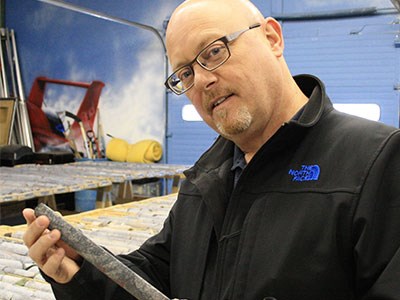“We didn’t know what it was – nobody knew what it was.”
That from Aubrey J. Eveleigh, president, CEO & director of Zenyatta Ventures Ltd. (TSX.V: ZEN), about a mysterious core sample drawn from the company’s Albany Project in northwestern Ontario during exploration drilling for copper and nickel. The consistent dark grey marbling through the rock was obviously something though. “We passed it along to Cliffs Natural Resources (an exploration partner at the time), a bunch of my colleagues who are geologists as well, and nobody had seen anything like it before.”
Eveleigh then sent samples to Dr. Andrew Conly, an associate professor of geology at Lakehead University.
He came back with the news that in fact what they had found was hydrothermal graphite, sometimes referred to as “vein” graphite – the rarest type of graphite known. Testing yielded greater than 99.9 per cent purity.
“That set us on a path that we didn’t expect. It’s proving to be a very special project, one of a kind, and the largest of its type in the world,” Eveleigh said.
It is hard to overstate exactly how important this find is.
High-purity graphite is used in many high-tech applications including the batteries in smartphones and similar portable devices, fuel cells for electric cars, powder metallurgy used in several industries including aerospace and the military, and for applications in the new generation of pebble bed nuclear power plants.
Normally, the 99.9 per cent purity needed for such applications requires multiple purification processes.
The raw material, needle coke, is a by-product of sweet oil drilling and therefore fluctuates in price year over year.
It is also very dirty to process – the irony of environmentally friendly cars is that their fuel cells contain graphite that requires quite a large carbon footprint to create.
Not so with the Albany Project graphite. Preliminary tests seem to indicate that relatively little processing would be required, making it very attractive to end users on both a cost basis and an environmental one. It would be almost like finding gold bars in your mine instead of gold ore.
“We’ve started to get some traction with global interest. We’ve signed various end users in Japan, Europe, and the U.S. that are looking at the material. They’re doing their own testing and it is proving out,” Eveleigh said.
The deposit itself is actually contained in two pipes, the explored depth of each equal to about the height of the CN tower, though much larger around.
Resource estimates put the total deposit at about 1.4 million tonnes of graphitic carbon, indicated and inferred.
Unlike the Ring of Fire, the mine location is just five-odd kilometres from a logging road and about 30 kilometres from the Trans-Canada Highway near Hearst.
The find is on Lake Constance First Nation traditional territory. Eveleigh said that the company already has a Memorandum of Agreement (MOA).
“We have a good relationship with them,” Eveleigh said. “We use their contractors when we can, and we hire their people. They are going to benefit greatly from this.”
Eveleigh deliberately tempers his enthusiasm about the find though. As a publically traded company, Zenyatta must undergo a preliminary economic assessment (PEA) conducted by an independent consultant done without any input from the company. At the time of this writing, the PEA’s release was expected shortly.
Although the PEA will provide an official figure of what it will cost to mine and produce high-grade, refined graphite, it will likely be a fraction of the cost of processing needle coke.
Even a layperson can see that on the face of it, this graphite deposit is extremely promising. It should cost much less to process, and the supply is large enough to make it very attractive to industry.
Unlike the downturn in chromite that negatively impacted the Ring of Fire, the demand for high-grade graphite is projected to grow as the high-tech battery and the fuel cell industries, in particular, grow.
Location is key, too – it is close enough to access roads that infrastructure development and investment would be minimal.
From a geological perspective, it’s obvious that Zenyatta’s graphite deposit is a one-of-a-kind find.
“It will probably be another hundred years before you find something like this,” Eveleigh said.




